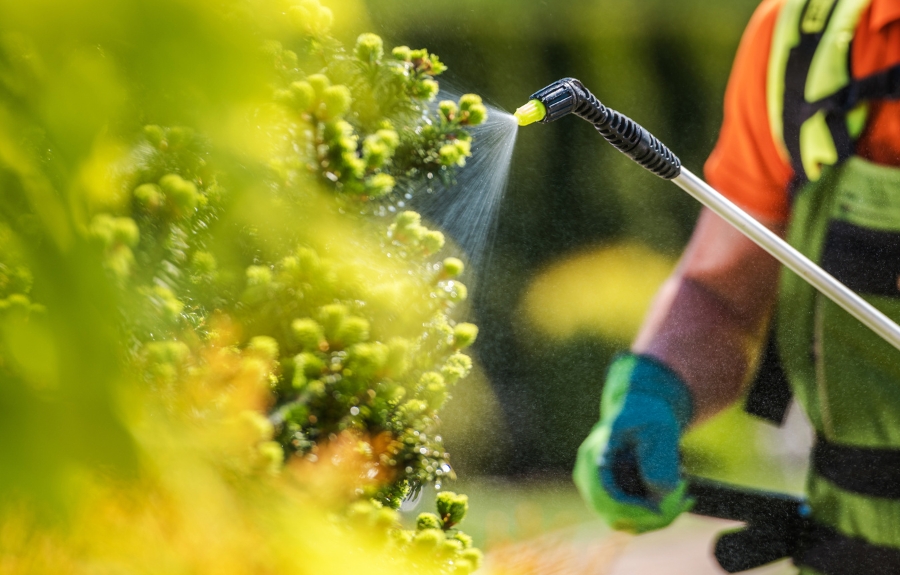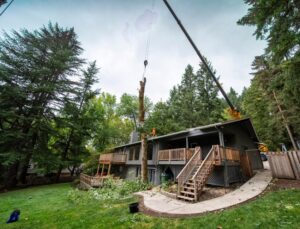5 Easy Steps to Keep Your Portland Trees Thriving Year-Round

Want to ensure your Portland trees thrive all year, every year? Healthy, strong, and beautiful trees don’t happen by accident in home landscapes. It takes intentional tree care to protect trees from damage and to help them thrive.
If you’re a homeowner in the Portland area who values the aesthetic of their trees, the shade and wind protection they provide, and the value they add to your property, then keep reading. We cover the 5 simple things you can do today to keep your Portland trees thriving in every season.
Key Takeaways: 5 Simple Tree Care Tips
- Use mulch to suppress weeds and manage moisture
- Fertilize your trees to provide the nutrients they need
- Adjust watering throughout the year
- Monitor for pests and diseases
- Practice regular pruning to help trees thrive
Tip #1. Apply Organic Mulch to Suppress Weeds and Manage Moisture
Organic mulch doesn’t just make your yard more attractive. It actively supports the well-being of trees and other plants.
WHAT IS ORGANIC MULCH? Organic mulch refers to any biodegradable plant-based material used as a protective top cover for soil. Common types include hardwood bark, wood chips, leaves, pine needles, straw, grass clippings, and cocoa hulls.
Firstly, organic mulch helps to retain moisture in the soil. It prevents moisture from evaporating too quickly, providing a consistent source of water for roots. This is especially important during our warm, dry summers here in Portland.
Related to this is the ability of mulch to moderate soil temperature. It acts as an insulator to keep soil cooler in summer and warmer in freezing winter weather.
Mulch also helps prevent soil compaction. When exposed to direct wind, rain, heavy snow, and foot or vehicle traffic, soil compacts, leading to denser soil. This makes it more difficult for water to penetrate the soil and prevents adequate drainage (possibly leading to root rot). A layer of wood chip mulch (or other types of organic mulch) also prevents erosion and water runoff, keeping tree roots protected.
A thick layer of organic mulch helps to prevent weeds from germinating, stopping them from robbing your trees of water and nutrients.
Lastly, as organic mulch breaks down, it adds nutrients to the soil and improves the soil structure, both of which help trees thrive.

Choosing the Right Type of Mulch for Your Portland Trees
Mulch comes in countless forms, and some are much better for tree health than others. The type of mulch you choose can affect not only your tree’s health but also the soil quality over time. Here are some popular mulch types and their best uses:
- Bark mulch: A durable and attractive option that decomposes slowly. Best for mature trees and decorative gardens.
- Pine straw: An affordable and lightweight choice that’s easy to apply. Best for young trees and vegetable gardens.
- Compost: Rich in nutrients, compost improves soil structure as it breaks down. Best for fruit trees and nutrient-needy plantings.
- Wood chips: Readily available and provide a natural look. Best for (sub)urban landscapes and paths.
- Grass clippings: Fast to decompose, grass cuttings release nitrogen back into the soil quickly. Best for trees adjacent to lawn areas.
Although gravel can look nice, it’s a poor mulch choice for trees. Gravel cannot hold and retain moisture. Rather, it retains heat, which can damage tree roots during the summer.
PRO TIP – Give tree trunks space! When spreading mulch around your trees, don’t create mulch volcanoes by piling mulch against the trunk in the shape of a mountain. This is detrimental to tree health. Keep mulch 12-18 inches away from the tree trunk, layer it 2 to 4 inches deep, and spread it all the way to the edge of the tree’s canopy (if possible). Fluff up the mulch every spring and, if it seems a little thin, add more to ensure you have full coverage.

Tip #2. Fertilize Your Trees to Provide the Nutrients They Need
Trees need a well-balanced diet, much like us, to maintain good health. They need specific nutrients from the soil to grow strong roots and healthy, green canopies. But the soil often found on residential lots typically lacks a robust nutrient profile (if you’ve ever watched a construction company remove all the topsoil before building a new house on a residential lot, you know why the remaining soil won’t keep your trees well-fed).
To give your trees what they need, fertilize them with specific formulas of nutrients to boost tree health. Here’s how to do it:
- Conduct a soil test to determine the nutrient makeup of the soil on your property. This will tell you what may be lacking and how much is needed for optimal tree health.
- Based on the test results, choose a slow-release fertilizer that matches your soil’s needs and provides a steady supply of nutrients over time.
- Apply fertilizers in late fall or early spring when trees start actively growing.
- Over-fertilization can be as harmful as under-fertilization, though it’s harder to over-fertilize with slow-release fertilizer.
PRO TIP – If you have a large yard, your soil nutrient profile may be different from one spot to another. Test soil samples across your yard, as you may need to apply different amounts or types of fertilizers in different areas.

Tip #3. Adjust Watering / Irrigation Throughout the Year
Here in Portland, your trees’ water needs will differ drastically depending on the season. Most of our annual rainfall occurs between November and March , while barely any rain falls in July and August. Your watering routine needs to change throughout the year to ensure your trees are never under or overwatered.
Watering in the Heat of Summer
Our Portland area yards receive very little rain in the summer, leading to dry soil and thirsty trees. Deep root watering is an effective technique that can satisfy a tree’s thirst for days, if not weeks at a time.
It’s best to use a dripline around the tree or a hose set on low volume (and moved frequently to ensure you provide water throughout the entire root zone). Water the area slowly, allowing the water to be absorbed deep into the soil rather than pooling on the surface. The goal is to moisten the soil 18-24 inches deep. Water early in the morning or in the evening to prevent unnecessary evaporation.
If you notice leaves that are wilting or yellowing around the edges, it could be a sign that your tree needs more water.
Watering in the Fall
Fall tends to be warm and dry as well. You should keep your summer watering habit going, though the frequency of with which you irrigate should decrease as more rain comes and temperatures drop.
Winter Watering Tactics to Prevent Desiccation
Watering in the winter isn’t critical as this is when Portland receives most of its rain. However, if you notice extended periods of dry weather, you can water your trees if temperatures are above 40 degrees. You likely won’t need to do this more than once or twice per month.
You’ll also want to water midday to avoid the risk of wet soil freezing overnight.
Watering in the Spring
Watering in the spring also isn’t too important since spring showers and above-freezing temperatures keep the soil moist. However, if you notice dry soil during the growing season, you can water once a week.

Tip #4. Regularly Monitor for Pests and Diseases
Portland’s wet climate can be a breeding ground for various fungal diseases, root rots, cankers, foliage diseases like needle cast, as well as insect pests like bark beetles. Regular monitoring and early detection can save a great deal of heartache and expense. By identifying problems early on, you can fight back before too much damage is done and keep your trees thriving.
Some problems that commonly affect trees in the Portland metropolitan area include:
- Shot Hole Disease
- Perennial Canker
- Phytophthora Root Rot
- Verticillium Wilt
- Anthracnose
- Bark Beetle Infestations (such as Bronze Birch Borer)
- Swiss Needle Cast (affecting Douglas-fir)
- Laminated Root Rot
- Armillaria Root Rot
- Fire Blight
Monitoring for pests and diseases is part of maintaining a healthy, flourishing landscape in our city. Unfortunately, it’s not always easy to diagnose the issue; many diseases have similar symptoms, and some pests are difficult to identify until they’ve already damaged your trees.
If you notice any issues with your trees, it’s a good idea to work with local tree care experts to diagnose, control, and prevent pests and diseases to ensure your trees stay healthy.

Tip #5. Practice Regular Pruning to Help Trees Thrive
Proper pruning and trimming are crucial to promote healthy tree growth and to prevent potential safety hazards. Pruning is one of the most effective things you can do to improve both the health and the appearance of your trees – but only when it’s done correctly.
If you plan to prune trees yourself, keep these tips in mind:
- Winter is ideal for pruning since trees are dormant and it’s easier to see the branch structure without leaves.
- Remove dead, damaged, or diseased branches whenever you see them to prevent the spread of decay.
- When cutting into diseased wood, clean your pruning tools between each cut to prevent spreading the disease.
- Ensure cuts are made just outside the branch collar to avoid damaging the tree’s healing tissue. Don’t leave stumps, and don’t cut flush against the tree trunk.
- Cut branches that rub against one another, as this leads to wounding. Prune off the less desirable of the two branches.
- Strategically pruning the tree canopy can help reduce storm damage.
While DIY pruning can be done on smaller trees, it gets a lot more difficult, and dangerous, when pruning large shade trees. If you have large trees on your property that haven’t been pruned in years (or ever), have certified arborists inspect your trees and provide a recommended pruning plan to maximize tree health and safety.
Let the Experts at ArborPro Help Keep Your Trees Thriving
Those of us who call Portland home know the value of our urban forest and how our trees benefit everyone. To keep our lush environment healthy, strong, and growing, trees need a little extra TLC to maximize their lifespan, especially in developed areas where growing conditions are far less favorable than in nature.
If you want to boost the health, strength, and safety of the trees on your property, without spending your weekends outside with a saw or bag of fertilizer in hand, let the expert, certified arborists at ArborPro help you. Our team takes great pride in caring for trees and keeping our city green. Call us at 503-473-8733 now or schedule a free estimate online, and we’ll help you craft the perfect tree care plan today.








